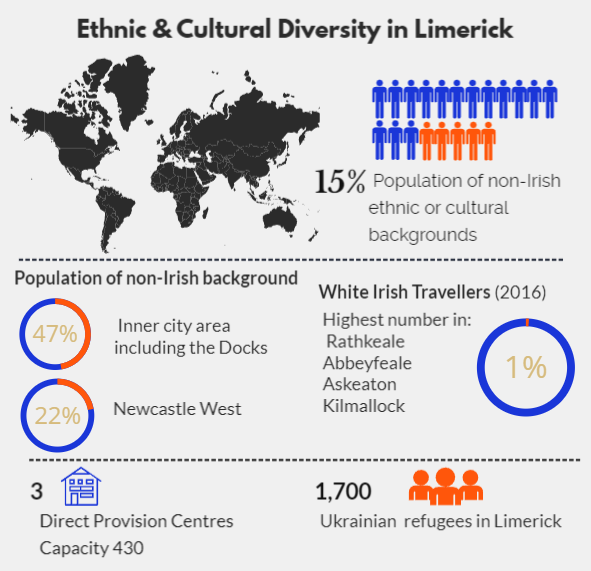2.2 Ethnic / Cultural Diversity
Demographic change and in-migration are making Limerick a more diverse and vibrant place. Immigration from different countries is contributing to cultural, economic and social diversity.
Ethnic Characteristics of the Population: Limerick
Incoming migrants with non-Irish nationality are also choosing to stay and raise families in Limerick. Based on Census 2016, approximately 85% of the population identify as White Irish, just under 1% White Irish Traveller and just under 15% are of different ethnic / cultural origin.
The percentage of the population self-identifying as White Irish Travellers in Limerick in Census 2016 under-estimates the size of this population. Concentrations of Traveller families are found in certain county towns, especially Rathkeale, Kilmallock, Abbeyfeale and Askeaton and in parts of the city. Accommodation is the key issue for Travellers. All indicators of well-being and social and economic inclusion indicate that Travellers are amongst our most disadvantaged social group – a very high percentage of this group have no formal or low education, they are at much higher risk of early school leaving, highest unemployment, poorest health and high mortality rates – and they also suffer discrimination.

In relation to people of non-Irish ethnicity / cultural background or who were not born in Ireland, the largest concentrations are in Limerick City centre. In the inner city area (population base of approximately 10,000), some 47% were not born in Ireland and within that, 22% were from “the rest of the world” apart from the UK and EU countries. There are also higher percentages of people who were not born in Ireland in parts of the suburbs (e.g., Dooradoyle-Raheen). Outside of the city and suburbs, Newcastle West has the largest percentage of its population (22%) born outside of Ireland.
Refugees and Persons Arriving Under International Protection
More recent issues emerging are the arrival and re-settlement of refugee populations linked to wars in other parts of the world – in particular, Syrian refugees and currently Ukrainian refugees. In summer 2022, there were approximately 1,700 known Ukrainian refugees in Limerick, processed through the International Protection Accommodation Services (IPAS). The local authority plays a key role in sourcing accommodation and putting in place a coordinated service response across public agencies to the Ukrainian refugee crisis.[1]
This is in addition to approximately 7,400 people seeking asylum / international protection in Ireland, living in Direct Provision Centres and emergency accommodation across the state.[2] The country of origin of people seeking asylum / international protection is mostly African countries (Nigeria, Somalia, and Zimbabwe) and Afghanistan. There are three Direct Provision Centres in / or serviced by Limerick City (one in Meelick Co. Clare) with occupancy capacity of some 430 persons. The numbers living in other accommodation options in Limerick, while waiting for a decision on their case, is not known. Hosting those seeking asylum in Direct Provision Centres, overseen by the International Protection Accommodation Services (IPAS), is due to end in 2024. A new accommodation model and support services are being developed for people seeking international protection.
There are a number of non-profit organisations in the city engaged in advocacy and providing support services to migrants including those arriving under and currently in the IPAS system – in particular, Doras engaged in advocacy and services and the Jesuit Refugee Service. The Local Development Companies in the city and county also target this population providing support services directly and referrals to mainstream services.
Migration places additional challenges on public services and infrastructure including housing / accommodation, education, health and other services. The quality of services, social and community infrastructure and amenities for a diverse and multi-cultural society will be a key determinant to achieve sustainable communities over the longer-term. Opportunities to engage in the cultural and civic life of host communities are essential for integration.
[1] Data from Limerick City and County Council
[2] Data from the Asylum Information Database (AIDA) / European Council on Refugees and Exiles (ECRD). https://asylumineurope.org/reports/country/republic-ireland/